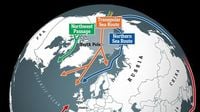Beneath the icy silence of the Arctic Circle, a new era of military brinkmanship is unfolding. Russia, long a dominant force in the region, has accelerated its efforts to fortify its northern frontier, amassing nuclear weapons and deploying attack submarines in a bid to secure strategic advantage over NATO allies. According to a sweeping investigation by The Washington Post and corroborated by statements from Norwegian and British officials, this buildup is not only a matter of numbers but of cutting-edge technology, clandestine procurement, and an evolving contest for control over vital shipping lanes as the Arctic ice recedes.
At the heart of Russia’s Arctic ambitions lies the Kola Peninsula, a remote stretch of land on the country’s extreme northwestern edge. This area, as Norway’s Defence Minister Tore Sandvik explained to The Telegraph on October 24, 2025, is now home to one of the world’s largest concentrations of nuclear warheads and serves as the operational base for Russia’s formidable Northern Fleet. “Russia is building up on the Kola peninsula... where one of the largest arsenals of nuclear warheads in the world is located,” Sandvik stated. “They [the nuclear weapons] are not only pointed towards Norway, but towards the UK and over the pole towards Canada and the US.”
The significance of the Kola Peninsula goes beyond its destructive potential. The region’s military infrastructure underpins what strategists call Russia’s ‘second-strike’ capability—the ability to retaliate with nuclear force should its own arsenal come under attack. This deterrent, experts say, is a pillar of Moscow’s superpower status, even as its conventional forces have suffered heavy losses in Ukraine. Over the past two years, Russia has launched a new frigate and a multi-role submarine, reinforcing its Northern Fleet despite the ongoing war.
But it’s not just about the hardware. According to a joint investigation by The Washington Post and European media partners, Russia has quietly constructed a vast underwater surveillance network known as Project Harmony. This system, built between 2013 and 2024, forms a semicircular barrier from Murmansk to Franz Josef Land, stretching across the seabed with hundreds of miles of sensors, antennas, and drones operating at depths of nearly 3,000 meters. The goal: to shield Russia’s nuclear-armed submarines from Western detection and to secure the Northern Fleet’s movements beneath the Arctic ice.
What makes Project Harmony especially notable is how it was built. Despite international sanctions, Russia managed to source sensitive technology—including sonar systems, underwater drones, and fiber-optic cables—from over 50 Western suppliers. Financial records and court documents reveal that a Cyprus-based front company, Mostrello Commercial Ltd, orchestrated these purchases. Among the suppliers were Norway’s Kongsberg Gruppen, US sonar manufacturer EdgeTech, and Japanese conglomerate NEC. A 2015 contract between EdgeTech and Mostrello, reviewed by The Washington Post, included Russian-language terms that left little doubt about Moscow’s involvement. EdgeTech’s sales chief Doug McGowen told reporters that the company had performed “a great deal of due diligence” and that Mostrello “was not on any denied parties lists” at the time of sale.
German authorities uncovered Mostrello’s role while prosecuting Alexander Shnyakin, a Russian-Kyrgyz trader convicted of coordinating illegal exports. The CIA reportedly warned Germany about Mostrello’s activities as early as 2021, but meaningful action only followed Russia’s full-scale invasion of Ukraine in 2022. David O’Sullivan, the EU’s Sanctions Envoy, acknowledged to German broadcaster NDR, “The Russians are very clever at circumventing our sanctions... there is no such thing as a perfectly watertight sanctions system.”
The implications of this secretive buildup have not gone unnoticed by NATO. British Defence Secretary John Healey, speaking to BBC News during a flight aboard the RAF’s new P-8 maritime patrol aircraft on October 24, 2025, warned of a “30% rise in Russian vessels threatening UK waters.” He added, “Russia is challenging us; it’s testing us; it’s watching us. But these planes allow us to say to Putin – we’re watching you; we’re hunting your subs.” The Ministry of Defence has reported that Russian submarine activity in the North Atlantic has returned to Cold War levels, prompting near-daily patrols by the RAF and Royal Navy, often joined by US and Norwegian allies.
German Defence Minister Boris Pistorius, who recently joined a joint patrol with the UK, stressed the strategic importance of the North Atlantic, calling it “crucial and... threatened by Russian nuclear submarines.” Both countries have pledged closer cooperation under the Trinity House Agreement, which includes joint production of torpedoes and expanded cyber-defence initiatives.
Meanwhile, the Arctic’s melting ice caps are opening new shipping routes, raising the stakes for control over two key choke points: the Bear Gap, a narrow passage between mainland Norway and Svalbard, and the GIUK Gap, a strategic corridor between Greenland, Iceland, and the UK. These routes are vital not just for commercial shipping—which now finds the Northeast Sea Route almost 40% shorter than the traditional Suez Canal path—but also as potential supply lines or flashpoints in a military conflict. As Sandvik told The Telegraph, “We are the eyes and ears of NATO in this area, and we see that they’re testing new weapons, for example hypersonic missiles, and they are testing nuclear-driven torpedoes and nuclear warheads.”
Despite Russia’s setbacks in Ukraine—where, according to Norwegian officials, one million Russian soldiers have died—Moscow’s Arctic ambitions remain undimmed. Sandvik cautioned, “Putin is not interested in peace... Putin’s plan is not a stable peace with Ukraine. If he can, he will come back. Even if we have a peace deal in Ukraine, with boots on the ground and a stable situation, one analysis is that he will mobilise millions of soldiers up close to the border with Finland.”
For Western strategists, the Arctic Circle is rapidly becoming the next “main security theatre” after Ukraine, as Sandvik put it. The region’s future will hinge not only on military hardware and surveillance networks, but also on the ability of NATO and its partners to adapt to new realities—where climate change, technological innovation, and geopolitical rivalry intersect beneath the polar night. As both sides fortify their positions and test each other’s resolve, the world’s attention is once again being drawn to the frozen frontier at the top of the globe.
In the high-stakes chess game unfolding in the Arctic, the moves made today will shape the balance of power—and the prospects for peace—far into the future.




